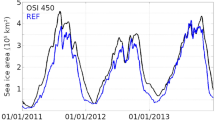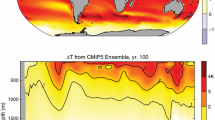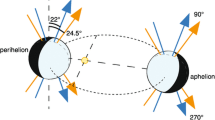Abstract.
A coupled atmosphere–ocean–sea ice–land surface climate system model developed at the Canadian Centre for Climate Modelling and Analysis (CCCma) is used to investigate the response to glacial ice-sheet topography and decreased CO2 representative of the last glacial maximum (LGM, roughly 21,000 years before present). Imposing these glacial boundary conditions leads to a strong and rapid climate adjustment, first in the atmosphere, and then in the ocean. We describe the model and boundary conditions and analyze the initial transient response. In a subsequent paper we analyze the near-equilibrium response. During the transient phase, surface air temperature rapidly decreases with time. The rapid cooling over the Laurentide and Fennoscandian ice sheets introduces a strong inter-hemispheric asymmetry. Sea surface temperature also decreases and after 80 years of integration, ocean surface temperature has decreased by 3 °C and global surface air temperature by 5 °C. The expected overall cooling is contrasted by marked regions of unexpected localized ocean surface warming and the retreat of sea ice in the northern North Atlantic and in the high latitude Southern Ocean. This strong transient behavior, associated with more vigorous oceanic convection at these high latitudes, represents the localization of the initial response in areas remote from the direct forcing change. The strength of the North Atlantic (Southern Ocean) overturning stream function, associated with the formation of North Atlantic Deep Water (Antarctic Bottom Water), increases from 12 to 36 Sv (2 to 26 Sv). There is a marked increase in the Antarctic Circumpolar Current transport as well (from 80 to 140 Sv), even though the wind stress decreases over the Southern Ocean, presumably as a consequence of the enhanced bottom pressure torque due to an increase in the density and the formation of Antarctic Bottom Water. Both precipitation and evaporation decrease on average with time and the change in the hydrological cycle modifies sea surface salinity (SSS). SSS increases in the Arctic Ocean due to a decrease in river runoff while it decreases in the North Atlantic due to an increase in river runoff and an increase in precipitation minus evaporation. The initial (and near equilibrium) climate response to LGM forcing in the fully coupled atmosphere–ocean climate model is quite different from that in the associated atmosphere-mixed layer ocean model due to very strong oceanic feedbacks. This is especially evident where oceanic convection is active. The anomalously warm surface temperature, especially in the Southern Ocean, and the marked increase in the overturning circulation are transient features of the response to imposed LGM boundary conditions which moderate or reverse as the system approaches equilibrium (as described in the companion paper). Other differences with the mixed layer simulation include a considerably colder tropical Pacific and the development of a La Niña-like response both of which are absent in the mixed layer simulations.
Similar content being viewed by others
Author information
Authors and Affiliations
Additional information
Electronic Publication
Rights and permissions
About this article
Cite this article
Kim, .SJ., Flato, .G., Boer, .G. et al. A coupled climate model simulation of the Last Glacial Maximum, Part 1: transient multi-decadal response. Climate Dynamics 19, 515–537 (2002). https://doi.org/10.1007/s00382-002-0243-y
Received:
Accepted:
Issue Date:
DOI: https://doi.org/10.1007/s00382-002-0243-y




